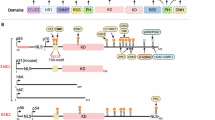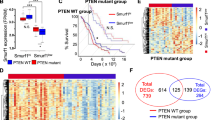Abstract
Mammalian target of rapamycin (mTOR) is a serine/threonine kinase that regulates a variety of cellular functions such as growth, proliferation and autophagy. In a variety of cancer cells, overactivation of mTOR has been reported. In addition, mTOR inhibitors, such as rapamycin and its derivatives, are being evaluated in clinical trials as anticancer drugs. However, no active mutants of mTOR have been identified in human cancer. Here, we report that two different point mutations, S2215Y and R2505P, identified in human cancer genome database confer constitutive activation of mTOR signaling even under nutrient starvation conditions. S2215Y was identified in large intestine adenocarcinoma whereas R2505P was identified in renal cell carcinoma. mTOR complex 1 prepared from cells expressing the mutant mTOR after nutrient starvation still retains the activity to phosphorylate 4E-BP1 in vitro. The cells expressing the mTOR mutant show increased percentage of S-phase cells and exhibit resistance to cell size decrease by amino-acid starvation. The activated mutants are still sensitive to rapamycin. However, they show increased resistance to 1-butanol. Our study points to the idea that mTOR activating mutations can be identified in a wide range of human cancer.
This is a preview of subscription content, access via your institution
Access options
Subscribe to this journal
Receive 50 print issues and online access
$259.00 per year
only $5.18 per issue
Buy this article
- Purchase on Springer Link
- Instant access to full article PDF
Prices may be subject to local taxes which are calculated during checkout




Similar content being viewed by others
References
Aressy B, Ducommun B . (2008). Cell cycle control by the CDC25 phosphatases. Anticancer Agents Med Chem 8: 818–824.
Chiang GG, Abraham RT . (2007). Targeting the mTOR signaling network in cancer. Trends Mol Med 13: 433–442.
Edinger AL, Thompson CB . (2004). An activated mTOR mutant supports growth factor-independent, nutrient-dependent cell survival. Oncogene 23: 5654–5663.
English D, Cui Y, Siddiqui RA . (1996). Messenger functions of phosphatidic acid. Chem Phys Lipids 80: 117–132.
Fang Y, Vilella-Bach M, Bachmann R, Flanigan A, Chen J . (2001). Phosphatidic acid-mediated mitogenic activation of mTOR signaling. Science 294: 1942–1945.
Guertin DA, Sabatini DM . (2007). Defining the role of mTOR in cancer. Cancer Cell 12: 9–22.
Inoki K, Corradetti MN, Guan KL . (2005). Dysregulation of the TSC-mTOR pathway in human disease. Nat Genet 37: 19–24.
Karbowniczek M, Spittle CS, Morrison T, Wu H, Henske EP . (2008). mTOR is activated in the majority of malignant melanomas. J Invest Dermatol 128: 980–987.
Kranenburg O . (2005). The KRAS oncogene: past, present, and future. Biochim Biophys Acta 1756: 81–82.
Kristjansdottir K, Rudolph J . (2004). Cdc25 phosphatases and cancer. Chem Biol 11: 1043–1051.
Molinolo AA, Hewitt SM, Amornphimoltham P, Keelawat S, Rangdaeng S, Meneses García A et al. (2007). Dissecting the Akt/mammalian target of rapamycin signaling network: emerging results from the head and neck cancer tissue array initiative. Clin Cancer Res 13: 4964–4973.
Ohne Y, Takahara T, Hatakeyama R, Matsuzaki T, Noda M, Mizushima N et al. (2008). Isolation of hyperactive mutants of mammalian target of rapamycin. J Biol Chem 283: 31861–31870.
Patel J, McLeod LE, Vries RG, Flynn A, Wang X, Proud CG . (2002). Cellular stresses profoundly inhibit protein synthesis and modulate the states of phosphorylation of multiple translation factors. Eur J Biochem 269: 3076–3085.
Ray D, Kiyokawa H . (2007). CDC25A levels determine the balance of proliferation and checkpoint response. Cell Cycle 6: 3039–3042.
Reiling JH, Sabatini DM . (2006). Stress and mTORture signaling. Oncogene 25: 6373–6383.
Robb VA, Karbowniczek M, Klein-Szanto AJ, Henske EP . (2007). Activation of the mTOR signaling pathway in renal clear cell carcinoma. J Urol 177: 346–352.
Sabatini DM . (2006). mTOR and cancer: insights into a complex relationship. Nat Rev Cancer 6: 729–734.
Sancak Y, Thoreen CC, Peterson TR, Lindquist RA, Kang SA, Spooner E et al. (2007). PRAS40 is an insulin-regulated inhibitor of the mTORC1 protein kinase. Mol Cell 25: 903–915.
Sato T, Nakashima A, Guo L, Tamanoi F . (2009). Specific activation of mTORC1 by Rheb G-protein in vitro involves enhanced recruitment of its substrate protein. J Biol Chem 284: 12783–12791.
Toschi A, Lee E, Xu L, Garcia A, Gadir N, Foster DA . (2009). Regulation of mTORC1 and mTORC2 complex assembly by phosphatidic acid: competition with rapamycin. Mol Cell Biol 29: 1411–1420.
Urano J, Sato T, Matsuo T, Otsubo Y, Yamamoto M, Tamanoi F . (2007). Point mutations in TOR confer Rheb-independent growth in fission yeast and nutrient-independent mammalian TOR signaling in mammalian cells. Proc Natl Acad Sci USA 104: 3514–3519.
Wang X, Proud CG . (2009). Nutrient control of TORC1, a cell-cycle regulator. Trends Cell Biol 19: 260–267.
Wullschleger S, Loewith R, Hall MN . (2006). TOR signaling in growth and metabolism. Cell 124: 471–484.
Acknowledgements
This work was supported by National Institutes of Health Grant CA41996.
Author information
Authors and Affiliations
Corresponding author
Ethics declarations
Competing interests
The authors declare no conflict of interest.
Additional information
Supplementary Information accompanies the paper on the Oncogene website
Rights and permissions
About this article
Cite this article
Sato, T., Nakashima, A., Guo, L. et al. Single amino-acid changes that confer constitutive activation of mTOR are discovered in human cancer. Oncogene 29, 2746–2752 (2010). https://doi.org/10.1038/onc.2010.28
Received:
Revised:
Accepted:
Published:
Issue Date:
DOI: https://doi.org/10.1038/onc.2010.28
Keywords
This article is cited by
-
Catalase-deficient mice induce aging faster through lysosomal dysfunction
Cell Communication and Signaling (2022)
-
Intracellular energy controls dynamics of stress-induced ribonucleoprotein granules
Nature Communications (2022)
-
A phase II study of sapanisertib (TAK-228) a mTORC1/2 inhibitor in rapalog-resistant advanced pancreatic neuroendocrine tumors (PNET): ECOG-ACRIN EA2161
Investigational New Drugs (2022)
-
Somatic mTOR mutation in clonally expanded T lymphocytes associated with chronic graft versus host disease
Nature Communications (2020)
-
Identification and characterization of two novel oncogenic mTOR mutations
Oncogene (2019)



